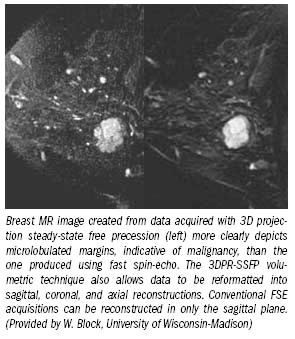3D breast MR technique offers exceptional detail
An MR technique that acquires data radially produces images of the breast with such detail that its developers at the University of Wisconsin believe it may eliminate the need for some biopsies.
An MR technique that acquires data radially produces images of the breast with such detail that its developers at the University of Wisconsin believe it may eliminate the need for some biopsies. The breast MR technique, which characterizes lesions depending on the in- and outflow of contrast media, may prove especially helpful in characterizing benign lesions that share some MR characteristics with cancerous ones.
As with conventional breast MR exams, the UW technique requires a contrast agent to be injected intravenously. The contrast flows into the vasculature of the breasts, illuminating all blood vessels. But it tends to remain longest in those feeding healthy tissue and benign lesions. This is because cancerous lesions grow too fast for the blood vessels that feed them to develop correctly.
The defective vessels leak the gadolinium-based contrast faster than healthy ones. Consequently, healthy tissues and benign lesions tend to demonstrate a clearly different wash-in and wash-out pattern of contrast than cancerous lesions. This is not always the case, however.

Some lesions accumulate contrast quickly, a wash-in hallmark of cancer, but then wash out at a slower pace, a characteristic typical of benign lesions. This is where conventional breast MR sequences fall flat.
“When you get those kinds of lesions, you go back to your T2-weighted images and see if there are certain morphological characteristics that would indicate that the lesion is likely to be benign,” said Walter Block, a UW-Madison associate professor of biomedical engineering and medical physics.
“Unfortunately, T2 imaging today is typically done in the sagittal plane with a sequence like fast spin-echo or turbo spin-echo. So the resolution in this slice direction is rather poor and you have gaps in between the slices.”
The UW technique, called 3DPR-SSFP (3D projection steady-state free precession), is geared specifically to overcoming this problem. When using the technique, data are acquired as an isotropic volume that can be sliced and viewed from any perspective. This allows lesions to be examined in detail, according to Block.
The physical characteristics of these lesions can be telltale indicators of whether they are malignant. Those with smooth edges often are benign; ones with jagged edges typically are cancerous.
Because volumetric acquisitions can be sliced at any angle and across any point, the shape of lesions also can be assessed completely. Single-plane acquisitions are not so helpful.
“If the morphology that would tip you off that something is benign is in a plane other than the one you’ve acquired, you’re out of luck,” Block said.
By capturing a volume of data that can be sliced in any direction, only one 3D sequence is needed to capture a complete set of data for 2D reconstructions. The method also allows the separate examination of data from fat and data from water. Differentiating fat is useful because it makes up a large portion of the breast.
“Most of the time radiologists concentrate on water images, because disease is rarely associated with fat,” Block said. “But sometimes fat images of the breast are useful. The boundaries of a lesion often stand out very clearly when [it is] embedded in fat.”
The potential of the UW technique has been shown in studies of about 20 patients at the University of Wisconsin Hospital. Block and colleagues are expanding their clinical evaluation with more patients. Additional feedback may soon come from the University of Toronto and Michigan State University, where researchers are preparing to conduct their own assessments of the technique.
Study Shows No Impact of Hormone Therapy on PET/CT with 18F-Piflufolastat in PCa Imaging
May 7th 2025For patients with recurrent or metastatic prostate cancer, new research findings showed no significant difference in the sensitivity of 18F-piflufolastat PET/CT between patients on concurrent hormone therapy and those without hormone therapy.